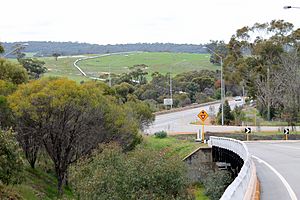Clackline Brook facts for kids
Clackline Brook is a small waterway in Western Australia, about 11.6 kilometers (7.2 miles) long. It starts near a town called Clackline. From there, it flows southeast towards Mokine. Then, it turns north and ends near Mokine Hill. Clackline Brook eventually joins another waterway called Spencers Brook. The name of the brook changes when it meets Corolin Brook.
Contents
Aboriginal History of Clackline Brook
The land around Clackline Brook was once home to several Aboriginal families. Their territories were often defined by the rivers and streams nearby. This area likely still holds special spiritual and cultural meaning for Aboriginal people. Even though there are no specific sites officially registered as of 2002, the connection to the land remains important.
European Settlement and Farming
European explorers first came to the Avon region in 1830. An expedition led by Ensign Dale explored the area inland from Guildford. Soon after, settlers arrived, and farming began. The town of Northam was officially established in 1836. Over the next 50 years, the region grew quickly, especially with the rise of farming. People primarily raised wheat, sheep, and cattle. The way land is used along the waterways hasn't changed much. However, there's a trend for larger farms to be divided into smaller plots for "hobby farming."
Water Challenges for Early Trains
In 1906, people discovered that the water from Clackline Brook wasn't good enough for steam trains. A well dug near the brook had too much lime and magnesia salts. A dam built in the brook near the Clackline railway station, meant to supply water for train engines, also had to be abandoned. Instead, water for the trains came from the Coolgardie water supply pipelines, which brought water from far away.
Modern Changes to the Brook
The Great Eastern Highway was rerouted to bypass Clackline. This project included the historic Clackline Bridge. Because of this new road, Clackline Brook was changed. It now flows through a large box culvert, which is like a big tunnel for the water.


